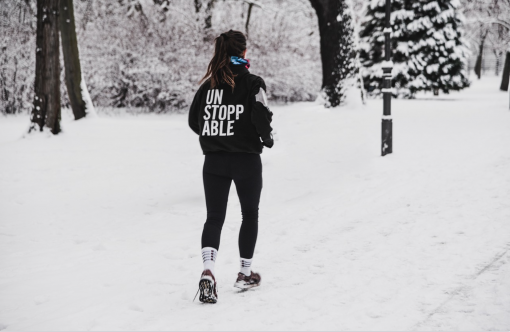
Fitness expert shares top safety tips for exercising outside during winter.
Christmas is soon and many will be focused on getting a head start on their New Year fitness resolutions as snow and ice are guaranteed for many in the United States of America ( USA) throughout December.
It is important to take safety into consideration when exercising outdoors. Matthew Magnante, an exercise author at FitnessVolt, has compiled a list of his most important safety tips to keep in mind when exercising outdoors during the colder months.
Drink Even If You Don’t Feel Thirsty
When exercising in colder temperatures, we are at an elevated risk of dehydration. Our blood vessels constrict when it is cold to reduce the amount of heat lost through our skin, as a way of maintaining our core body temperature. During this process a hormone called plasma arginine vasopressin(AVP) that normally signals thirst, is secreted at a lower rate than when exercising in hot weather. This explains why you might find yourself craving water less when exercising in winter.
Research has found that exposure to cold weather can reduce our thirst sensation by as much as 40%. To prevent dehydration, continue to drink water as you would during summer and opt for a glass of water before heading out and continue to sip on a drink throughout and after your workout. Also, don’t forget to fuel your body with food before exercising outdoors. You typically burn more calories in cold weather to maintain your core body temperature, so it is important to prioritize nutrition if you want to maintain energy throughout your workout.
Opt for Polyester not Cotton t-shirts
| If you find yourself prone to sweating while exercising, cotton is one of the worst materials you can wear when the temperatures drop. Cotton is highly absorbent which means that as you sweat the material tends to stay wet rather than drying out. Water conducts heat away from the body up to 25 times faster than air, which means you will lose body heat much more quickly in colder temperatures and increase your risk of developing hyperthermia. Moisture-wicking materials such as polyester or wool will keep you warmer because their fibres absorb less water, and dry out quickly. Polyester fibres are designed to insulate you even when wet by trapping a layer of air between the fabric and your skin, while the shape of its fibres are designed to remove water. A three-tier layering system works best, comprised of a base layer such as polyester, a main layer such as wool and a waterproof outer layer that repels rain, snow and wind. This way you create multiple layers of insulation while allowing sweat to move through the layers and evaporate into the air rather than clinging to your clothes. Cut your sessions in half Running on snow and ice engages different muscles to running on dry ground, due to the reduced friction and uneven surfaces. Consequently, you are likely to put yourself at risk of injury if you try to complete your regular running distance without first adapting to the new conditions. A good rule of thumb when running on icy routes is to halve your regular running distance until you have adapted to running on slippery or uneven surfaces. Allow yourself 4-6 weeks of regularly running on snow or icy terrain, before you start to build back up to your regular running distance. Reducing the distance between each step will also help to keep your feet under your centre of gravity and allow you recover more easily should you lose your balance. As you become more comfortable on these surfaces, you can gradually widen back up to your regular stride. Say where you are going Even for the most confident among us, it is important to let someone know where you are going before you head out on a walk or run during winter. For iPhone users, you can temporarily enable location sharing on the Find My App which will enable family, friends or your partner to track your location should you slip and injure yourself while exercising on ice or snow. |
Stretch Before and After Exercise
Stretching before you exercise is particularly important in winter, as your muscles tend to contract to conserve heat, which makes them more prone to injury. Try to incorporate dynamic stretches before you head out for a winter run, to increase your muscles’ internal temperature and reduce the risk of injury. Body weight squats, calf raises, and good old-fashioned jumping jacks are effective dynamic stretches that get the blood flowing and increase your core body temperature, before you head outside. Post workout, you want to perform static stretches, which require you to stretch and hold a muscle group for 15-30 seconds. Static stretches also help to reduce injury but should only be used as part of a cool down routine, to help lower your heart rate and relax your muscles. Common static movements include hamstring stretches, quad stretches and calf stretches.
Cut Your Sessions in Half
Running on snow and ice engages different muscles to running on dry ground, due to the reduced friction and uneven surfaces. You are likely to put yourself at risk of injury if you try to complete your regular running distance without first adapting to the new conditions. A good rule of thumb when running on icy routes is to halve your regular running distance until you have adapted to running on slippery or uneven surfaces. Allow yourself 4-6 weeks of regularly running on snow or icy terrain, before you start to build back up to your regular running distance. Reducing the distance between each step will also help to keep your feet under your center of gravity and allow you to recover easier should you lose your balance. As you become more comfortable on these surfaces, you can gradually widen back up to your regular stride.
Tell Where You Are Going
Even for the most confident among us, it is important to let someone know where you are going before you head out on a walk or run during winter. For iPhone users, you can temporarily enable location sharing on the Find My App which will enable family, friends or your partner to track your location should you slip and injure yourself while exercising on ice or snow.
To spotlight your fitness products and services, contact Fromgirltogirl.com by email advertise@fromgirltogirl.com. View our content marketing services for packaged deals.
